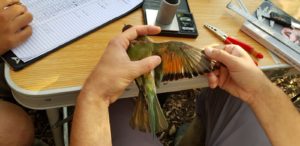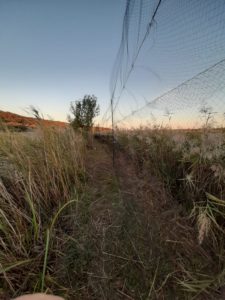We’re going to tell you all about ringing
At A Rocha, we’ve been ringing birds for 20 years. But why?
Have you ever seen a bird and asked yourself where it came from, where it’s going and why?
At A Rocha, we’ve been asking ourselves these questions for quite some time, and it’s thanks to scientific ringing (‘banding’ in the US), practised for many years by our teams, that they’ve found an answer. Here’s a quick look at the whys and wherefores of this process, which allows us to refine our knowledge of these magnificent little creatures.
Ringing consists of identifying individual birds by a metal ring on the leg. Each ring has its own alphanumeric code. In addition, other markings are used for certain species and studies, such as coloured rings and collars.
 The ring code and the measurements made on the bird are stored in a database, which we can supplement with data from later recaptures of the same individual. In this way, we can find out the movements of the birds, the dates of departure and arrival, the migration routes, the breeding and wintering grounds, etc. It also allows us to study the behaviour of the birds. And it also allows us to study mortality and survival rates, turnover rates and population morphology, biometric and moult data.
The ring code and the measurements made on the bird are stored in a database, which we can supplement with data from later recaptures of the same individual. In this way, we can find out the movements of the birds, the dates of departure and arrival, the migration routes, the breeding and wintering grounds, etc. It also allows us to study the behaviour of the birds. And it also allows us to study mortality and survival rates, turnover rates and population morphology, biometric and moult data.
The sharing of all this information at national and international level makes it possible to understand the evolution of different populations and to design policies for the conservation and management of bird species.
In the Vallée des Baux, A Rocha France is studying the course of migration (phenology) through the “PHENO” protocol, created by the Centre de Recherche sur la Biologie des Populations d’Oiseaux (CRBPO), the French public body responsible for managing the ringing and marking of birds, which is part of the National Museum of Natural History. Once a week, we carry out a ringing session. Before dawn, we place the nets in our ringing area and use loudspeakers with the sounds of the migratory species to attract them to the nets. Every half hour we collect the birds that fall into the nets, ring them and measure them.
 This year the sessions started in the last week of August and over 630 birds of 36 different species were ringed!
This year the sessions started in the last week of August and over 630 birds of 36 different species were ringed!
The most numerous species were the Reed warbler (Acrocephalus scirpaceus) and the Blackcap (Sylvia atricapilla), with more than one hundred birds of each species, followed by the Blue tit (Cyanister caeruleus) with more than eighty birds, and the Chiffchaff (Phylloscopus collybita) with more than fifty birds.
But the species are not always the same because they change throughout the migration, for example, the Willow warbler (Phylloscopus trochilus), the Wryneck (Jynx torquilla) and the Reed warbler are caught at the beginning of the migration, while the Chiffchaff, the Reed bunting (Emberiza schoeniclus), the Robin (Erithacus rubecula) and the Blackcap are caught in the last weeks.
To study certain species, we need a specific capture method, as part of the “VOIE” protocol. A Rocha France uses this protocol to monitor the Barn swallow (Hirundo rustica). From the end of August to the beginning of October, ringing is carried out once a week in the swallow dormitory in the Baux marshes. The protocol is similar to the PHENO protocol but takes place before nightfall. The swallows are caught in the net as they lie down in the reedbed. We collect them and then ring and measure them in a safe place during the evening, before releasing them the next morning.
This year we ringed over 1,300 swallows, 98% of them Barn swallows, in seven banding sessions. Three of them had already been ringed abroad, in Germany. So it was a nice surprise to find them in our nets several months later, and always a wonder at the ability of these fragile migrants to make such journeys.
